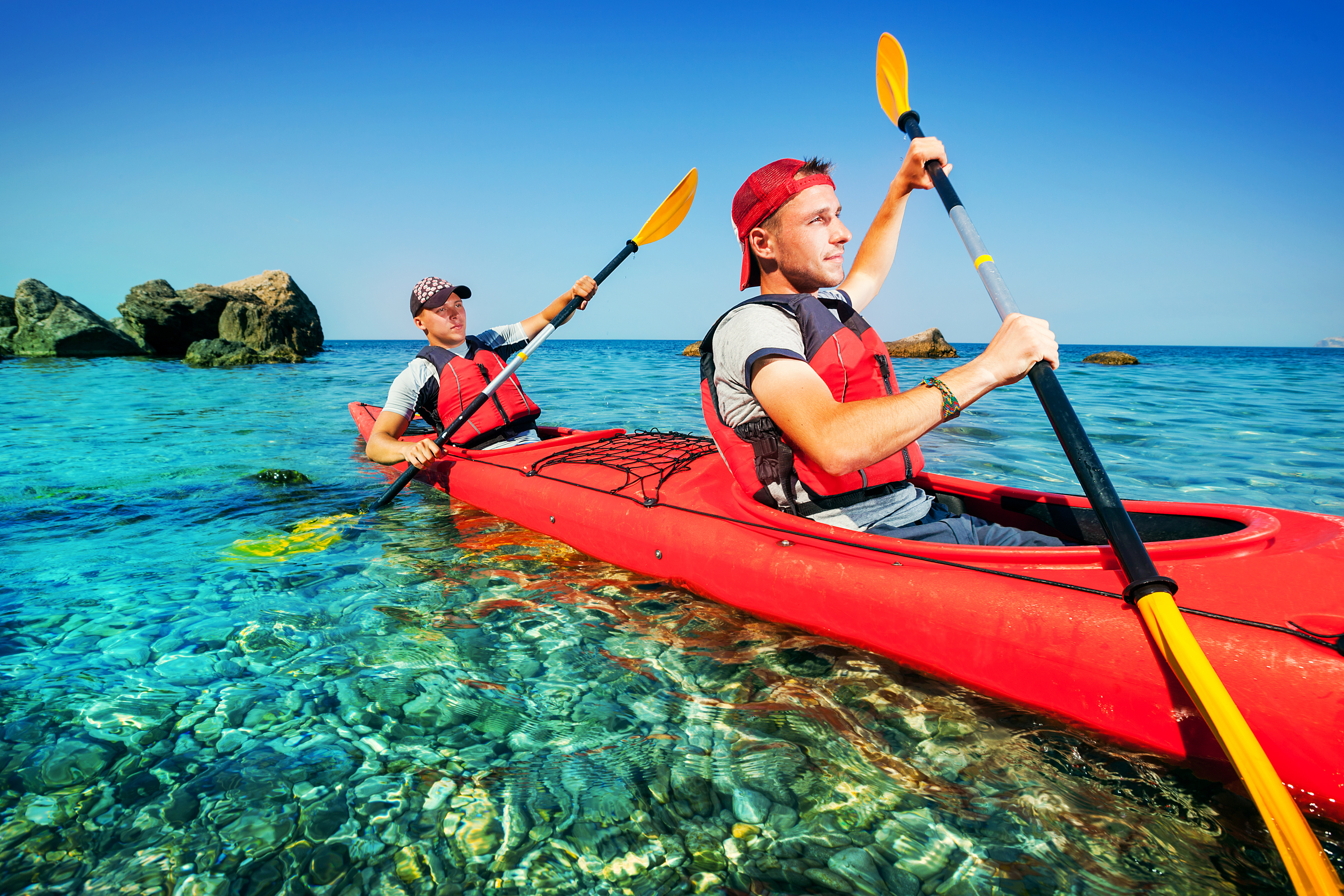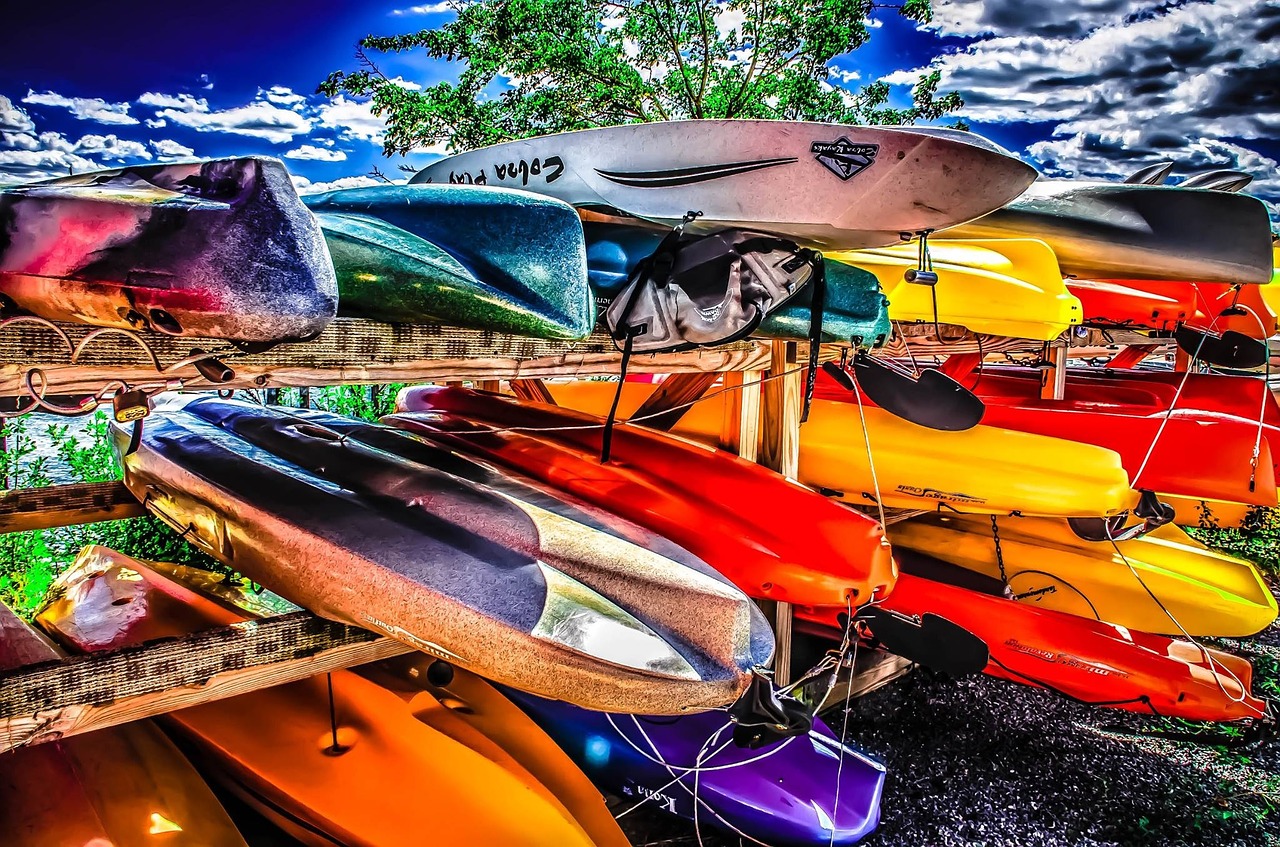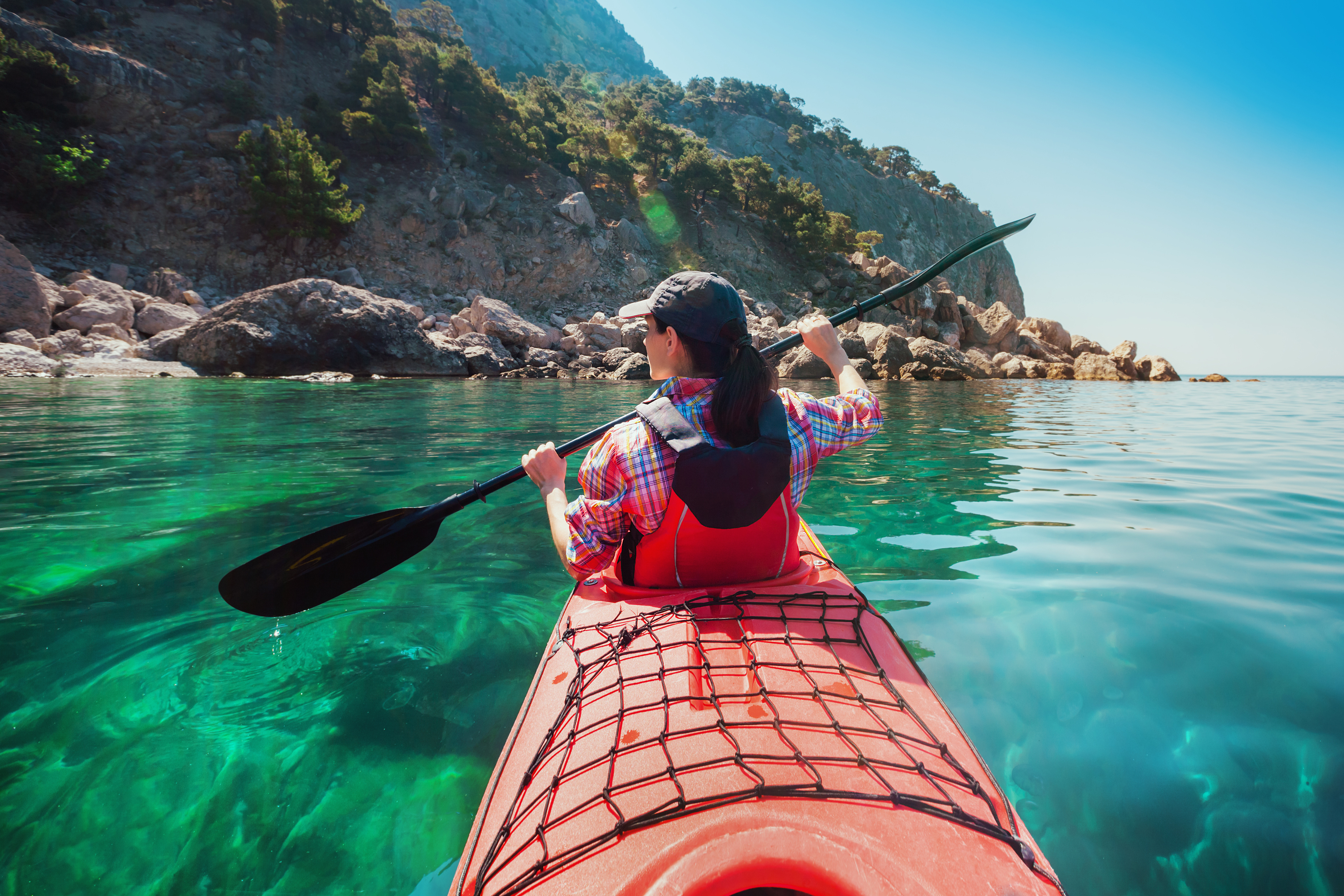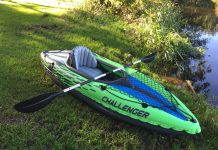
If you’re learning to kayak or have always wanted to try it, we’ve compiled this ultimate guide to kayaking for beginners to answer all your questions. Our goal is for you to be a paddling pro and know the ins and outs of your new hobby by the end of this post.
So, whether you’re a die-hard outdoor enthusiast picking up a paddle for the first time, or a city dweller that’s used to nothing but tarmac beneath your feet, we’ve got you covered.
But first, let’s answer one simple question…
Why Take Up Kayaking?
Kayaking means many things to many people.
For families, it’s the chance to have fun on the water each time summer rolls around. For thrill seekers, it’s about chasing the adrenaline rush of whitewater. And for anglers, it’s an opportunity to access the best fishing spots.
People from all walks of life decide to take up kayaking for a variety of reasons. However, the common theme throughout, is fun and adventure.
You have your own boat, and you’re free to explore and enjoy nature any way you wish.
That’s the core of kayaking that makes it such an incredible pastime.
Benefits of Kayaking
Apart from being an all-out awesome experience (okay, as a paddling addict, I may be a little biased), kayaking offers amazing health benefits for both the body and mind.
Here are some of the things you can look forward to when you take up paddling:
- Exciting Adventure – Owning a kayak will create unforgettable memories as you explore rivers, lakes, and coastlines, and their surrounding landscapes.
- Stress Relief - There’s no better way to escape the hustle and bustle of everyday life than being in the great outdoors.
- Fun Exercise – Let’s not forget the fitness element. Paddling is a fun workout that trumps running on the hamster wheel or going through the drudgery of a weights routine.
- Cheap Hobby – After the initial purchase of your kayak and a couple of safety items, you won’t need anything else to keep enjoying paddling.
Types of Kayaking
Once upon a time, kayak use was purely functional; arctic tribes used the lightweight vessels for transport and to hunt offshore.
Nowadays, kayaks are mainly used for recreational activities and competitive sports.
Here’s a roundup of the many different ways kayaks can be used.
- Recreational Kayaking – Good for beginners who want enjoy a leisurely paddle in rivers, lakes, or at the beach. Kayaks can be rented for an afternoon of fun with friends and family.
- Sea Kayaking – Paddle the coastline and explore beaches and coves, some of which will only be accessible by boat. Experience is required due to the challenging conditions created by waves and tidal movements.
- River Kayaking – An excellent way to explore the backcountry. Get dropped off at the put-in point and lazily make your way down the river over several days of paddling and camping. Be conscious of your abilities and skill level as rivers can be dangerous (and even deadly) if you don’t have the skills to paddle them.
- Whitewater Kayaking – River kayaking but with the added excitement of navigating rapids. Not for the beginner or the faint hearted, and training must be undertaken before attempting whitewater kayaking.
- Competitive Kayaking – Got a competitive streak? Kayaks can be used for sprint racing, slalom, and endurance events.
- Kayak Fishing – Anglers are no longer restricted to fishing from the bank or paying for expensive charters.
- Hunting – Traveling along rivers or across lakes allows hunters to pursue game found deep in the bush.
- Photography – Putting a slight twist on recreational kayaking, nature photographers use kayaks to snap unspoiled and rarely seen natural beauty.
- Camping – Kayaks and canoes make great transport for campers and hikers exploring the backcountry.
Selecting a Kayak - Which Type of Kayak is Right for You?

Selecting a kayak can be difficult if you don't know what you're looking for
Here’s where it gets confusing for new paddlers.
For each of the activities listed above, there exists a different type of kayak. Some kayaks can be used for multiple activities, such as recreational kayaks also being suitable for fishing, but no one type does everything.
If you’re looking to buy your own kayak, deciding on a single type can be damn tricky. Clear things up by answering one important question:
“Where do I want to kayak?”
You may have several destinations in mind, but narrow it down to a couple of locations you’ll paddle most often. Do you stay near the beach and plan to paddle the ocean, or are inland waterways more readily available?
Matching the kayak to the water body or activity you plan on doing will ensure you’re prepared for the conditions likely to be encountered.
Even after you’ve decided which sub-group of kayak is right for you, picking one from the many different options can be overwhelming.
Fishing kayaks, for example, come in sit-in and sit-on-top versions, can fit two or even three people, and have a mind-boggling amount of accessories available.
Length, width, and hull shape are also important factors to consider, as they influence the stability, speed, and manoeuvrability of the kayak.
Generally, the longer and narrower a kayak is, the faster it will be. If you know you’re going to be covering a lot of ground, then you should be scoping out kayaks that are at least 12 feet long.
If you’re not paddling large distances, then a shorter kayak is much easier to control on the water and to move around and store out of the water.
At this point, you’re probably getting a little flustered by the whole thing. However, there’s no need to fret.
I would suggest reading online reviews of kayaks you think would be suitable, or better yet, visit your local paddling store and tap into the knowledge of an experienced paddler.
If you tell them where you plan on going, who you want to take along, and what other activities you plan on doing, they’ll be able to match you with the right kayak.
Kayaking Equipment
Once you’ve got your kayak sorted, there are still a couple of items you’ll need before hitting the water. Don’t worry, there’s not too much more gear required and there are budget and second-hand options available.
The two essential items you’ll need to go along with your kayak are a paddle and PFD.
PFD – Would you drive a car without a seatbelt on? No, you probably wouldn’t. Well, paddling a kayak without wearing a PFD (Personal Flotation Device) is pretty much the same thing. And similarly to not wearing your seatbelt, paddling without a PFD is illegal in many states.
Having a PFD that is a snug fit is just as important as actually wearing it. A loose fitting PFD will not keep your head above water if you happen to capsize. It will ride up over your head, obstructing your visibility and making it difficult to swim.
Paddle – Kayak paddles come in a variety of styles and materials and vary widely in quality. Budget paddles can be picked up for as little as $30, whereas top-of-the-line, lightweight, carbon fibre paddles will set you back several hundred dollars.
The cheapest option is usually an Aluminium shaft with plastic blades. They’re heavy and somewhat clunkier than they’re top-end counterparts, but are fine for your first paddle.
Plus, you can always upgrade your paddle in time and keep old paddle as a spare.
The main thing you should be concerned with is getting a paddle that is correctly sized.
Other Accessories – I would also recommend beginners invest in a dry bag. They’re a great place to store spare clothes, first aid kits, non-perishable food (trail mix), and other valuables.
Now, there are a lot more paddling accessories than this, but you can add to your inventory as and when you need to. The exception is that if you decide to get into whitewater or fancy taking up kayak fishing, you will need additional specialist gear.
However, with a kayak, paddle, and PFD, you’re all set to enjoy a leisurely paddle. Well, maybe not just yet. We first need to cover some basic safety principles…
Basic Kayak Safety for Newbies
Kayaking is a relatively safe activity once you know what you’re doing and take basic safety precautions.
Your local paddling club will offer kayak training that will teach you paddling techniques and safety. But if you’re not interested in taking lessons at this stage, here are our must-know nuggets of wisdom for staying safe on the water.
This isn’t the fun stuff, but listen up, because it’s damn important.
Can You Swim?
Being able to swim is one of those basic safety considerations you need to observe.
Before ever parking your butt in a kayak, you should be able to swim at least 100 metres. You never know what may happen out on the water, and in the event of capsizing, you should be able to tow your kayak to the shore and re-enter from there.
If you can’t swim, get lessons before thinking of kayaking.
Stay With Your Kayak
If you happen to fall out of your kayak and don’t know how to perform a wet entry, make sure you grab hold of your kayak (and paddle if you can).
It’s much easier to stay afloat if you hold onto your kayak, and it’s easier for rescuers to spot you.
You should practice swimming with your kayak and paddle under controlled conditions. It’s good practice in the event you find yourself capsized for real.
If you train to swim 50 metres with your kayak, then you will always feel safe when you keep within this distance of the shore or exit point.
The easiest method of swimming with a kayak is to swim on your back and kick your legs while holding the carry handle and paddle with one hand, and using the other arm to help stay afloat.
Don’t Go Alone
It’s always more fun going paddling with your buddies, but it’s also much safer.
Other paddlers can offer instruction, first aid, call for help, provide a tow, or help out in many other ways if you get stuck.
Never venture out yourself until you are completely confident in your ability to handle you yak. And even then, you should stick to familiar routes, avoid adverse weather conditions, and follow the trip advice below.
Basic Trip Planning Goes a Long Way
Our ultimate guide to planning a kayak trip covers every aspect of trip planning, but here are essential safety tips to follow on every kayak outing.
Bring Enough and No More – Bring only what you need to be safe and comfortable on the water. Any more, and it will end up being exhausting to move the load.
Double Check Weather Reports – You are much more vulnerable in a kayak than you are on land. A mild breeze on the shore can feel like gale force winds in the middle of a lake.
Check the local weather report of the place you’re visiting and check again just before leaving.
If you’re paddling rivers, look for rainfall over the river catchment area – heavy rain upstream can cause the downstream river to swell and turn into flood conditions quickly.
Do You Remember Orientation 101? – If you’re heading out into the backcountry, pack a map and compass or a GPS, so you always know where you are and the direction you’re heading. Guides providing details of the dangers on the river will also keep you right.
Provide Notification – Have you let friends and family know the details of your trip (where, when, and how long)? Share the details of your trip with several people and leave a reminder note.
What’s Your Emergency Plan? – Do you have an emergency plan in place? What if the group gets separated? Do you have a meeting point? Are emergency supplies split between a couple of group members?
Paddling Clothing
Pay attention to your choice of clothing when paddling.
Some materials absorb and retain water like a sponge. Wearing heavy and moisture absorbing materials for kayaking, such as cotton, will leave you cold and wet for hours and possibly even at the risk of hypothermia.
You should opt for synthetic materials such as polyester or thermals. Your clothing should be lightweight and not bulky so that you can wear multiple layers easily.
You can quickly become hot and sweaty when paddling hard, and then cool down rapidly when you get soaked. Layering allows you to adjust to the temperature changes quickly, and is the key to remaining comfortable when paddling.
If you’re paddling in high winds, wind chill can make it feel much colder than it actually is. A good quality windproof jacket is just what you need.
Wetsuits can keep you warm and are an excellent choice when you’re learning to kayak and likely to be taking a dip or two. Their only downside is that they’re restrictive and can chafe at the underarms.
To keep your feet comfortable, paddlers sometimes opt for wetsuit booties as they keep your feet warm when wet. However, a pair of lightweight running shoes will do the trick.
Where to Kayak

Where will kayaking take you?
Just about any body of water is suitable for kayaking, but not all of them are suitable for beginners.
If you’re new to the activity, we recommend you start in a sheltered pond, lake, or reservoir, and stay within safe swimming distance of the shoreline at all times. High winds, currents, motor boats, and anything else that creates waves is going to make learning difficult.
Learning balance, paddle strokes, and how to manoeuvre in still water will build confidence and ensures you don’t find the whole process too overwhelming. Once you’re comfortable captaining your own ship, you can expand into moving water and trickier waterways.
For most, lakes and slow-moving rivers provide all the excitement and adventure we need. There’s an endless supply of calm waterways each with their own nooks and crannies to explore, flora and fauna to marvel at, and secret spots to be fished.
However, the adventurous bunch who wish to explore coastal regions and try their hand at whitewater, can do so after learning the skills.
Kayak and Canoe Clubs
Taking lessons is the fastest way to improve in any interest and kayaking is no exception. Kayaking and canoeing clubs exist in most cities and major towns, and a quick Google search may reveal a few in your area.
You can get one-on-one training or group sessions that cover everything from basic paddling techniques, to more advanced Eskimo roles and whitewater paddling skills.
Joining a club will put you in touch with experienced paddlers who can offer tips and advice and who know all the best waterways.
Besides quality instruction, you’ll also make paddling friends and have more opportunities to go on kayaking day trips.
Learning Paddle Strokes and Techniques
As mentioned above, joining a paddling club is the easiest and fastest way to learn all the strokes and techniques.
However, beginners only need to know the forward, sweep, and reverse strokes to have control over their boat.
These three strokes will allow you to go forwards, backwards, change direction, or turn on the spot.
They are usually demonstrated to you when you hire a kayak or go on a day trip, or you can easily learn them over on the internet. They’re not hard at all, and even complete newbies will have picked up these strokes by the end of their first session.
Paddling in Rough Conditions
First off, you shouldn’t be attempting to kayak in choppy water until you’ve got the hang of balancing and you can control your kayak with ease.
Waves are a challenge for the beginner paddler. They unnerve you, throw you off-balance, and may even cause you to capsize.
Paddling in the sea or at lakes that have high winds or motorboats passing through can be difficult to navigate.
The trick is to face the wave head on. If you remain parallel, you’ll be violently rocked from side to side and water may even come over the top and flood the cockpit. Paddling through the waves at an angle is the safest method of travelling through choppy water.
Each change in water conditions brings with it a different style of kayaking and type of kayak that is best suited to the conditions. It’s nothing to concern yourself with at the moment, but just keep it in the back of your mind.
A Quick Word on Kayaking Etiquette
Before we end our beginners guide to kayaking, I think it’s important to emphasize that, as a paddler, you have a moral obligation to respect our environment and to be considerate of other people using the waterway.
Nature’s beauty is there for us all to enjoy.
Whether you’re camping, paddling, or hiking outdoors, we should always aim to leave the place the same or better than we found it.
We should also remember to share our environment and be respectful of others. No one person or group owns our outdoor world. You have to be polite and share waterways with anglers, boaters, and yes, even those annoying Jet Ski riders.
Be conscious of other people using the waterway. Only cross busy, high trafficked paths if it’s necessary and when safe to do so, and try to do it as quickly as possible.
Similarly, you should also respect landowners and not dock or camp on private grounds. If they allow you to camp, don’t set large fires or tear down branches to make shelters.
It’s all about being respectful, courteous, and giving other people the room they need, so that we can all enjoy the Great Outdoors.
Wrapping It Up
For anyone that’s learning to kayak or always thought about it, I hope you’ve picked up something useful from our guide.
Kayaking is a phenomenal sport that can provide almost anything you want: fun, adventure, excitement, competition – you decide.
I can think of no better way to spend your weekend than having a good time and keeping fit and healthy in the Great Outdoors. It’s no wonder that those that give kayaking a go end up becoming life-long paddling fanatics.
Kayaking for Beginners Video Walkthrough
Check out this video of a first time paddler. She receives ten minutes of kayak lessons on the beach, then is all set. See, it’s not hard at all.
As an Amazon Associate, we earn from qualifying purchases. This is without any additional costs for the buyer but does support us in maintaining our website.



